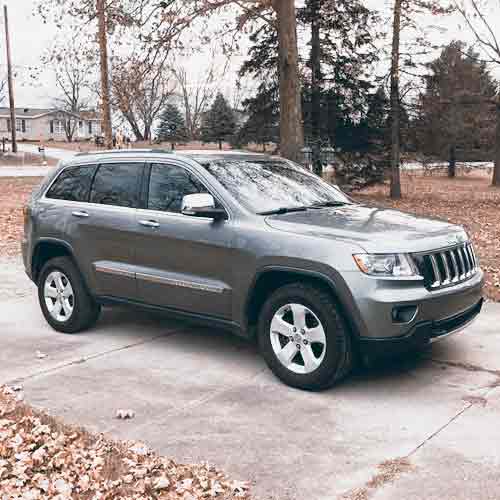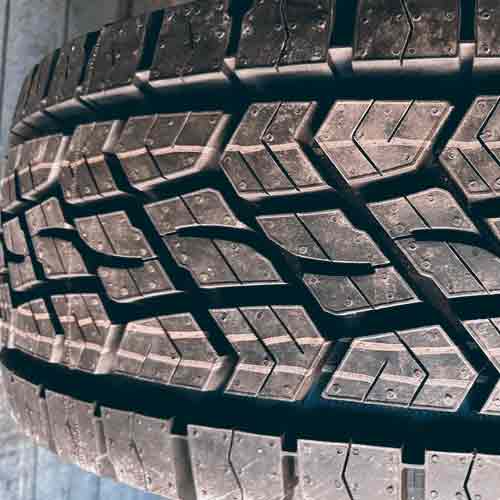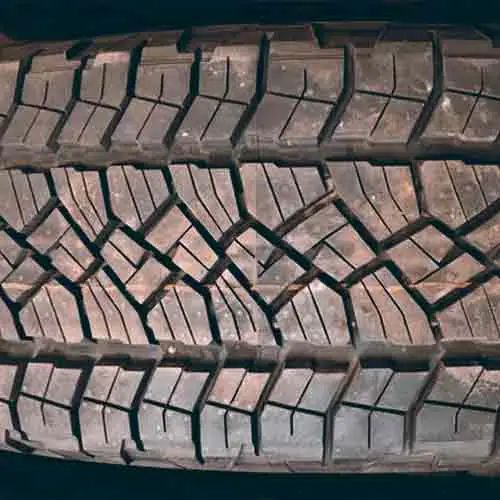The General Grabber APT and Continental TerrainContact AT are both on-road oriented all-terrain tires, each offering a unique blend of capabilities and features. But which one is better? Well, you’re about to find out.

Main Findings
As a tire engineer, my analysis indicates that the Grabber APT excels in the following areas:
- Dry Handling: Offers better lateral traction and quicker steering response.
- Off-Road Capabilities: Superior performance in sand and light mud conditions, particularly.
- Impact Comfort: Is one of the most comfortable A/T tires out there, thanks to its ComfortPlus technology.
- Winter Performance: Stands out with its 3-peak mountain snowflake rating, offering better snow grip and handling.
Detailed Review of General’s tire: https://tiredriver.com/general-grabber-apt-review/
Conversely, the TerrainContact A/T demonstrates superior performance in following aspects:
- Longitudinal Grip: Exhibits shorter braking distances and better directional grip.
- Wet Traction: Superior in water dispersion and resistance to hydroplaning, attributed to its full-depth sipes and efficient groove design.
- Noise Reduction: My tests show that it’s the quietest tire in its category.
Detailed review of Continental’s tire: https://tiredriver.com/continental-terraincontact-at-review/
Sizes Facts
| Specs | Terrain Contact A/T | General Grabber APT |
|---|---|---|
| Rim Sizes | 16 to 20 inches | 16 to 22 inches |
| Speed Ratings | S, T, H, V | R, S, T, H |
| Load Ratings | SL, XL, C, D, E | SL, XL, C, E |
| Weight Range | 28 to 67 lbs | 28 to 58 lbs |
| Tread Depth | 12 to 16/32″ | 13 to 16/32″ |
| Ratings | Only M+S | 3PMSF and M+S |
| Warranty | 60,000 miles | 60,000 miles |
Noise Reduction
The TerrainContact A/T, from my perspective as a tire engineer, is the quietest all-terrain tire. In fact its the main reason why I ranked it in my list of top A/T tires. Check it out here: https://tiredriver.com/best-all-terrain-tires/
So what makes it so great here? Let me explain.
While noise is generated by rolling and varying surface textures, a significant portion actually originates from air movement. Actually air gets compressed in and out of the tire, and with air particles striking the tread walls, all kinds of unwanted sounds originate, including in-groove resonance, tread vibrato, cavity noise and so on.
Now the Continental A/T addresses it at the source. I mean if you consider its shoulder blocks, you’d note that besides being relatively more packed up, they also have ridges blocking the lateral grooves (in between the lugs).

This design significantly reduces the flow of the air to begin with.
Moreover, the tire also features slightly better pitch sequencing compared to Grabber APT.
What’s that? Well simply put its a design element where lugs are placed in a way so they could turn noise in to various tones, which then try to cancel each others’ frequencies.
Wet Traction
Now wet traction is not something all-terrain tires are good at, as its a bit tricky and involves clearing off water from underneath the tread in time.
And if water isn’t dispersed efficiently and quickly, it can lead to substantial slippage or worse, hydroplaning (floating of the tire).
Now this is where sipes and grooves come in. And this is how they work: So, grooves take out majority of water, and sipes come in later, which work to absorb remaining moisture coming right underneath the tread blocks.
Understanding this, I can now explain why its the weakest performance aspect of the General Grabber APT.
This is mainly because the sipes on this tire tend to stiffen up during intense maneuvers, reducing their effectiveness and water dispersal capabilities.

Basically, General tire’s siping is more oriented towards performing on snow, and they can’t offer as much traction on wet roads.
On the other hand, the TerrainContact A/T has more flexible siping.
And its grooves take out relatively greater amount of water at the start, reducing the burden on its sipes to begin with.
So in comparison the tire not only excels in wet traction and handling but also delivers superior resistance to hydroplaning.
For Your Info: Out of all the “on-road oriented” all-terrain tire’s I’ve reviewed, the Cooper Discoverer Road+Trail (review) provides the best wet performance overall.
Dry Performance
Understanding a tire’s performance on dry surfaces means looking at its linear and lateral grip as well as its steering response. Let’s investigate these aspects.
Directional Grip
Directional grip refers to a tire’s ability to maintain traction in a straight line, and is primarily determined by braking tests.
And in this section, the Continental TerrainContact AT comes out better thanks to its densely packed lugs and more efficient biting edges, (talking about its in-groove notches in particular). These features contribute the most to the tire’s shorter braking distances (comparatively).
Though, you should know that the performance gap between these tires here is still minimal. I mean in my tests, which involved decelerating from 60 to 0 mph, the difference was only less than half a foot on average.
This marginal difference is largely due to the General Grabber APT’s lighter weight, where its reduced mass generates less momentum inertia, facilitating easier stopping.
But of course, with a more voided structure it still can’t surpass Continental A/T.
Overall Handling
Overall handling is all about how well your tire responds to steering and how much lateral grip it’s got.
Now, when it comes to these two key aspects, the Grabber APT takes the cake. Let me explain why.
Let’s dive into lateral traction first. Sure, the Continental tire is more packed up, but the Grabber’s interlocking shoulder lugs still offer better cornering traction (where the tire showcase relatively greater lateral g-forces on my averaged tests).
But why focus on the shoulders? Well, as the tire takes a turn, the edges of the tread make more contact with the road, compared to lugs in the middle.
And they are the ones compressing against the road the most, a factor which tells you about the tire’s steering response. I mean the more the lugs bend, the slower is the feedback from the wheels.
That’s why here the APT being a little lighter has lugs which are relatively less susceptible to bending. And with that, those tread blocks snap back to their original shapes quicker.
This means there’s less lag between you turning the wheel and the tires doing their thing, compared to the TerrainContact A/T. That’s why General APT is able to provide 1 mph faster handling speed (on average), on my lap tests.
Though keep in mind, that there are still better options out there (for on-road performance). And if you’re exploring it would be best to start from my main A/T tire page.
Off Road Performance
All-terrain tires are engineered with an emphasis on off-road performance, which often necessitates compromises in on-road handling. However, the General Grabber APT distinguishes itself with its exceptional performance across various (mildly) rugged environments.
Here’s an overview of its performance in different terrains against Continental tire.
Navigating Sand
Sand driving is inherently difficult due to its softer nature, which demands a larger contact area for the tire to avoid sinking and maintain traction.
That’s why tires work better here when they are deflated. This action increases the tire’s footprint, significantly lowering the likelihood of becoming stuck.
So what makes Grabber APT better here? Well despite having stiffer sidewalls, the tire offer better sand-optimized sidewall lugs, which still prevents the tire from digging (into sand) as much as the TerrianContact.
Plus its “staggered” edges design is also pretty helping.
It allows for an effective scooping motion, propelling sand backwards and thereby aiding in forward movement. This attribute is especially beneficial on deeper sandy surfaces.
Light-Mud Performance
The performance of a tire in muddy conditions hinges largely on its tread design, where particularly the size and arrangement of the grooves are the most important.
That’s why here TerrainContact A/T with its narrower grooves (relatively) is more susceptible to mud packing, quickly leading to a loss of traction. Whereas the Grabber APT provides better mud evacuation thanks to its superior inter-connectivity of voids.
Plus the General’s laterally arranged grooves combined with scalloped shoulders (missing in Continental) also help particularly in providing forward propulsion.
I mean the tire is more adept in kicking mud backwards and generating stronger acceleration against it. This very feature also makes the tire less prone to getting stuck.
But yes, both of these tires aren’t going to handle aggressive muddy trails, that’s for sure.
Traction on Rocks
Navigating over rocks demands a tire that combines durability, strong sidewalls, and versatile gripping capabilities.
Regarding durability, the General Grabber APT shows notable competence for its category (of on-road oriented A/T tires).
This is largely thanks to its DuraGen technology which integrates stronger cut-resistant rubber and reinforced polyester cords into the sidewalls, offering a superior level of puncture resistance.
And although the tire’s sidewalls aren’t the strongest, they powerful staggered shoulder lugs on top of them still provide a reasonable protection along with grip, especially when the tire pressure is lowered.
Furthermore, the central tread area of the General tire (distinguished by interconnected grooves) having multi-directional biters, provide greater traction from all angles compared to TerrainContact A/T.
This multi-angled grip comes in real handy when it comes to climbing rocks.
Impact Comfort
Out of all the A/T tires I’ve reviewed, the General Grabber APT stands out as one of the most comfortable tires.
This excellence in its “impact comfort” performance is attributed to two main features:
- The incorporation of ComfortPlus technology.
- The tire’s uniquely flexible lugs.
The ComfortPlus technology involves a specialized layer embedded within the tire’s internal structure, just beneath the rubber. This layer is ingeniously crafted to mitigate road shocks and vibrations, significantly elevating the overall comfort of your journey.
Furthermore, the tire’s lugs are designed to be relatively more flexible.
This flexibility plays a vital role in effectively absorbing and dispersing the bumps and inconsistencies found on road surfaces, preventing them from being transmitted into the vehicle’s cabin.
So you get a much smoother ride with this tire compared to Continental TerrainContact A/T.
A Side Note Here: If you’re wondering which tire is rated as best for impact comfort (in my books), it’s actually Yokohama G015 A/T. You can check out this tire here: https://tiredriver.com/yokohama-geolandar-g015-review/
Winter Performance
When it comes to winter performance, which covers everything from light snow to deeper terrains and icy patches, a good tire needs to have solid grip, acceleration capabilities, and lateral stability.
And considering all these aspects, it can be seen why the Grabber APT does better overall. But I guess it would not come as a surprise, considering it’s the only one in this comparison with a 3-peak mountain snowflake rating.
So what makes General tire better over TerrainContact A/T?
Well, this is because of its interlocking tread pattern with lugs that are oriented laterally. This setup allow lugs to scoop out the snow backwards more efficiently, creating superior acceleration (particularly in deeper snowy terrains).
And yes its staggered shoulders further help that “scooping” process too.
Moreover, these lugs also make for better snow-on-snow contact, which is the key for performance on light snowy terrains, because snow sticks to snow way better than it does to rubber.
On the other hand, the Continental A/T does offer reasonably good snow contact, thanks to its snow vices, which are also particularly useful on ice. But the tire still lacks to Grabber overall, mainly due to its less effective composition.
Its rubber is not an all-weather compound and lacks thermally adaptive properties. This means that in colder environments, its biters freeze quicker and lose effectiveness, impacting overall performance.
Wrapping Up
So the tire choice here boils down to what you value most. I mean with each tire showcasing distinct strengths, it’s difficult to crown an overall champion.
The Continental excels in dry grip, wet traction, and noise reduction, with better braking distances and hydroplaning resistance.
In contrast, the Grabber APT shines in handling, off-road capabilities, impact comfort, and winter performance, outperforming in lateral traction, sand and light mud conditions, and snow handling due to its 3-peak mountain snowflake rating.
Overall, while both tires have their specialized areas, the Grabber APT stands out in more challenging conditions, and the Continental A/T in everyday driving comfort (in terms of noise), and safety.